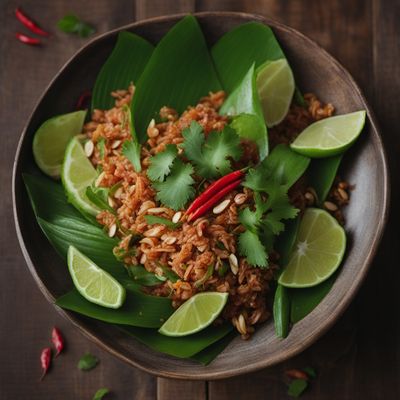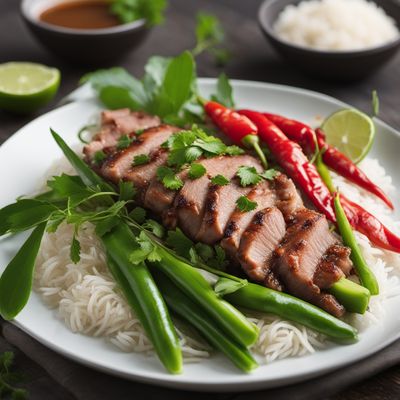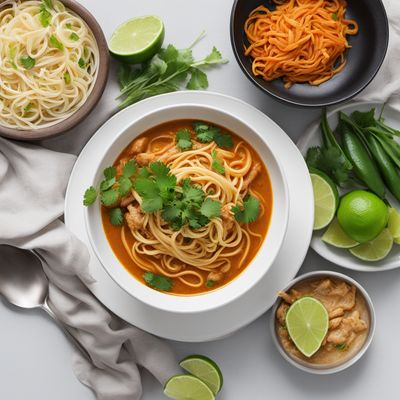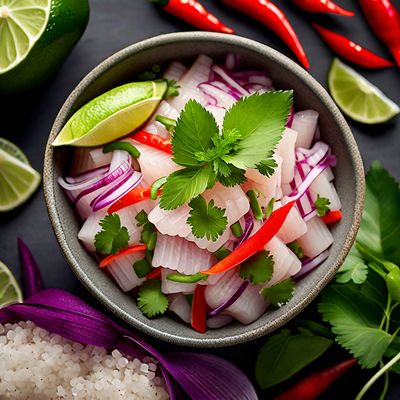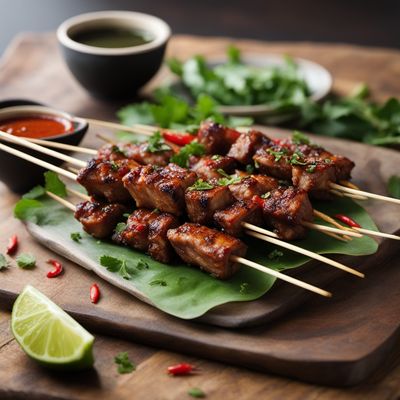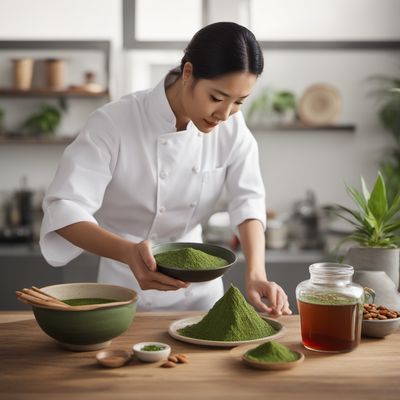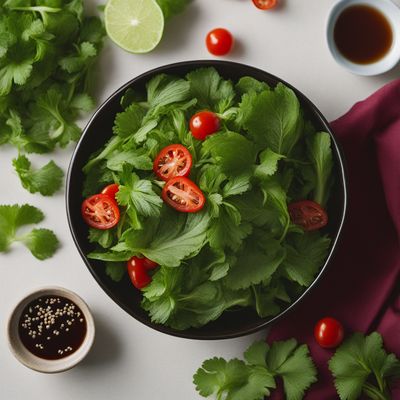
Recipe
Chinese Buddhist Miang Kham
Enlightened Leaf Wraps: Chinese Buddhist Miang Kham
4.7 out of 5
Chinese Buddhist Miang Kham is a delightful dish that combines the essence of Thai cuisine with the principles of Chinese Buddhist cooking. This recipe offers a unique twist on the traditional Miang Kham, incorporating Chinese Buddhist flavors and ingredients.
Metadata
Preparation time
20 minutes
Cooking time
N/A
Total time
20 minutes
Yields
4 servings
Preparation difficulty
Easy
Suitable for
Vegetarian, Vegan, Buddhist, Gluten-free, Dairy-free
Allergens
Peanuts, Coconut
Not suitable for
Meat-based diets, Seafood-based diets, Nut allergies, Soy allergies, Egg allergies
Ingredients
Chinese Buddhist Miang Kham differs from the original Thai version by incorporating Chinese Buddhist flavors and ingredients. The recipe replaces certain ingredients that are not commonly used in Chinese Buddhist cuisine, such as shrimp paste and fish sauce, with vegetarian alternatives. Additionally, the Chinese Buddhist version may include specific herbs and spices that are traditionally used in Chinese Buddhist cooking. We alse have the original recipe for Miang kham, so you can check it out.
-
20 betel leaves 20 betel leaves
-
1 cup (240ml) vegetarian oyster sauce 1 cup (240ml) vegetarian oyster sauce
-
1 cup (240ml) tamarind paste 1 cup (240ml) tamarind paste
-
1 cup (240ml) palm sugar 1 cup (240ml) palm sugar
-
1 cup (240ml) roasted peanuts, crushed 1 cup (240ml) roasted peanuts, crushed
-
1 cup (240ml) dried shredded coconut 1 cup (240ml) dried shredded coconut
-
1 cup (240ml) diced tofu 1 cup (240ml) diced tofu
-
1 cup (240ml) diced jicama 1 cup (240ml) diced jicama
-
1 cup (240ml) diced pineapple 1 cup (240ml) diced pineapple
-
1 cup (240ml) diced cucumber 1 cup (240ml) diced cucumber
-
1 cup (240ml) diced red bell pepper 1 cup (240ml) diced red bell pepper
-
1 cup (240ml) diced green apple 1 cup (240ml) diced green apple
-
1 cup (240ml) diced mango 1 cup (240ml) diced mango
-
1 cup (240ml) chopped fresh cilantro 1 cup (240ml) chopped fresh cilantro
-
1 cup (240ml) chopped fresh mint leaves 1 cup (240ml) chopped fresh mint leaves
-
1 cup (240ml) chopped fresh Thai basil leaves 1 cup (240ml) chopped fresh Thai basil leaves
-
1 cup (240ml) chopped roasted cashews 1 cup (240ml) chopped roasted cashews
Nutrition
- Calories (kcal / KJ): 250 kcal / 1046 KJ
- Fat (total, saturated): 15g, 3g
- Carbohydrates (total, sugars): 25g, 15g
- Protein: 8g
- Fiber: 5g
- Salt: 0.5g
Preparation
-
1.In a small saucepan, combine vegetarian oyster sauce, tamarind paste, and palm sugar. Heat over low heat until the sugar dissolves. Set aside to cool.
-
2.Prepare the filling by combining diced tofu, jicama, pineapple, cucumber, red bell pepper, green apple, mango, cilantro, mint leaves, Thai basil leaves, and roasted cashews in a large bowl.
-
3.Pour the cooled sauce over the filling mixture and toss gently to coat.
-
4.To assemble, take a betel leaf and place a spoonful of the filling mixture in the center. Fold the leaf to form a neat parcel.
-
5.Repeat with the remaining betel leaves and filling mixture.
-
6.Serve the Chinese Buddhist Miang Kham as an appetizer or a light snack.
Treat your ingredients with care...
- Betel leaves — Ensure that the betel leaves are fresh and free from any blemishes. Wash them thoroughly before using.
- Vegetarian oyster sauce — Look for a vegetarian oyster sauce made from mushrooms or soybeans as a substitute for the traditional oyster-based sauce.
- Tamarind paste — Use a high-quality tamarind paste for the best flavor. If unavailable, you can substitute with tamarind concentrate or pulp.
- Palm sugar — If palm sugar is not readily available, you can substitute it with brown sugar or coconut sugar.
- Dried shredded coconut — Toast the dried shredded coconut in a dry pan over medium heat until golden brown for added flavor.
Tips & Tricks
- For a spicier version, add finely chopped chili peppers to the filling mixture.
- Experiment with different fruits and vegetables to personalize the flavors of the Chinese Buddhist Miang Kham.
- Serve the dish with a side of vegetarian dipping sauce for an extra burst of flavor.
- If betel leaves are not available, you can use lettuce leaves as a substitute.
- Prepare the filling in advance and assemble the Chinese Buddhist Miang Kham just before serving to maintain the freshness and crispness of the betel leaves.
Serving advice
Chinese Buddhist Miang Kham is best served as an appetizer or a light snack. Arrange the wrapped betel leaves on a platter and garnish with additional fresh herbs. Serve with a side of vegetarian dipping sauce for dipping.
Presentation advice
To enhance the presentation of Chinese Buddhist Miang Kham, arrange the wrapped betel leaves in an attractive pattern on a serving platter. Garnish with sprigs of fresh herbs and sprinkle some crushed peanuts on top for added texture and visual appeal.
More recipes...
More Thai cuisine dishes » Browse all

Sai kok
Sai kok is a traditional Chinese dim sum dish that is made with glutinous rice flour and filled with a savory filling.

Pla duk phat phet
Spicy Fried Catfish
Pla duk phat phet is a Thai dish made with crispy fried catfish and a spicy sauce. It is a popular dish in Thailand and is often served with rice.

Nam chim chaeo
Nam chim chaeo sauce
Nam chim chaeo is a Thai dipping sauce that is typically served with grilled meats or vegetables. It is a sweet and sour sauce that is easy to...
